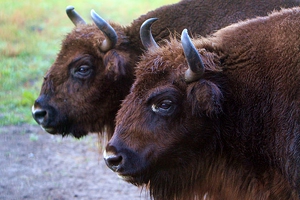Ru
|
Eng
Belarus, Poland work on cross-border bison population project
26.08.2015

Belarus and Poland are busy working out a project to develop a cross-border bison population, representative of the Ministry of Natural Resources and Environment of Belarus Natalia Minchenko told a press conference to mark the 55th anniversary of the foundation of the environment protection system of Belarus on 26 August, BelTA informs.
“Among the areas of our activity which we can be proud of is the restoration of the number of rare and endangered species, in particular bisons that have become a symbol for our country. We are currently working together with our counterparts from Poland on the project to develop a cross-border bison population, expand its areals,” she stressed.
Not long ago the Belovezhskaya Pushcha played host to a meeting with polish representatives to discuss the issue. “We have an agreement to work on the project. We are currently looking through the issues which should be included into the document. Besides, the project is supported by the Council of Europe. Perhaps, Lithuania will join the project,” she said.
According to Natalia Minchenko, the project will be implemented in the Belovezhskaya Pushcha and hunting entities located to the north of the reserve. “It is early to talk about the deadlines of the project. The procedure will need at least a few years to pass all its stages, submit and approve the project and address the issues related to its financing,” she said.
According to Natalia Minchenko, Belarus tops the list of countries with the number of free roaming bisons. “With only 10 bisons in the 1940s we have already exceeded the number of 1,200 animals,” he said.
The Ministry of Natural Resources and Environment has developed and approved a concept for bison preservation and sustainable use in Belarus. The main objectives of the concert is the further growth and stabilization of the number of the Belarusian bison population in the country at the level that guarantees its long-term presence – 1,500 species; the development of the genetic potential of the population; the promotion of a stable growth of various micro populations.
“Among the areas of our activity which we can be proud of is the restoration of the number of rare and endangered species, in particular bisons that have become a symbol for our country. We are currently working together with our counterparts from Poland on the project to develop a cross-border bison population, expand its areals,” she stressed.
Not long ago the Belovezhskaya Pushcha played host to a meeting with polish representatives to discuss the issue. “We have an agreement to work on the project. We are currently looking through the issues which should be included into the document. Besides, the project is supported by the Council of Europe. Perhaps, Lithuania will join the project,” she said.
According to Natalia Minchenko, the project will be implemented in the Belovezhskaya Pushcha and hunting entities located to the north of the reserve. “It is early to talk about the deadlines of the project. The procedure will need at least a few years to pass all its stages, submit and approve the project and address the issues related to its financing,” she said.
According to Natalia Minchenko, Belarus tops the list of countries with the number of free roaming bisons. “With only 10 bisons in the 1940s we have already exceeded the number of 1,200 animals,” he said.
The Ministry of Natural Resources and Environment has developed and approved a concept for bison preservation and sustainable use in Belarus. The main objectives of the concert is the further growth and stabilization of the number of the Belarusian bison population in the country at the level that guarantees its long-term presence – 1,500 species; the development of the genetic potential of the population; the promotion of a stable growth of various micro populations.
SCIENCE. TECHNOLOGY. INNOVATIONS
13.08.2024
28.06.2024
28.06.2024
25.06.2024
05.06.2024
15.05.2024
15.05.2024
26.04.2024
26.04.2024
26.04.2024













